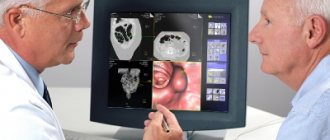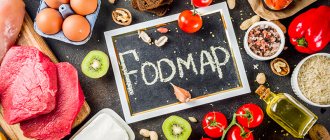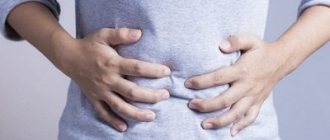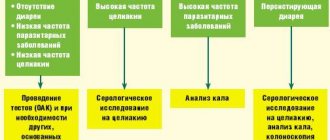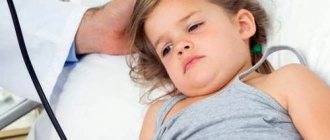Colitis - symptoms and treatment
Colitis (Latin colitis, from the Greek kolon (large intestine) and itis (inflammation) is a collective concept that includes a large group of diseases with one common feature: inflammation of the large intestine.
The main signs of colitis: frequent loose stools with blood, abdominal pain and high fever.
Colitis is encountered in the practice of gastroenterologists, infectious disease specialists, therapists, coloproctologists, surgeons and other specialists.
Etiology of colitis
The main forms of colitis can only be described separately, depending on the etiological factor. The size of the article does not allow us to touch on all types of colitis. Let's consider only the main ones.
Infectious colitis is an intestinal disease that occurs due to the activation of opportunistic microorganisms in the intestine or the entry of new pathogenic microbes from the external environment.[1]
Infectious colitis is very widespread: there is no person who has never suffered from this disease. The number of cases increases during hot periods, when favorable conditions are created for the spread of infection. Therefore, people in regions with hot climates (Africa, Southeast and Central Asia) get sick more often. The disease is more common in childhood, especially in children attending educational institutions (kindergartens, schools, etc.). Gastroenterologists and proctologists may encounter patients with this pathology in their practice, but it is not their specialty. The disease is usually treated by infectious disease specialists.
Causes of infectious colitis:
- bacteria (Shigella, Escherichia, Salmonella, Clostridia, Yersinia, Typhoid Bacillus, Campylobacter, Proteus, Staphylococcus);
- viruses (adenovirus, enterovirus, rotavirus);
- protozoa (amoeba, lamblia, etc.);
- pathogens of tuberculosis and syphilis;
- fungi (candida, actinomycetes). The occurrence of fungal colitis indicates a decrease in immunity and often occurs in people suffering from AIDS receiving chemotherapy and steroid hormones;
- dysbiosis.
Forms of infectious colitis:
- catarrhal;
- fibrous;
- catarrhal-hemorrhagic;
- phlegmonous;
- phlegmonous-gangrenous;
- necrotic.
Inflammatory phenomena can have a staged nature, or they can immediately have a picture of advanced inflammation. Its severity directly depends on the nature of the infection. Necrotic and phlegmonous-gangrenous inflammation occurs with clostridial infection. Catarrhal-hemorrhagic - for dysentery. Catarrhal inflammation occurs more often in viral diseases.[2]
Ischemic colitis is an inflammation of the wall of the large intestine that occurs due to disruption of circulatory processes. There are chronic and acute circulatory disorders.[3]
The cause of circulatory disorders is a complete cessation or critical decrease in blood flow to the colon, resulting in inflammation. In severe cases, it can lead to necrosis of the intestinal wall. The cause of blockage of blood vessels can be blood clots, but most often atherosclerotic plaques lead to narrowing of the lumen of the vessel. Therefore, the disease more often manifests itself in older people. About 79% of patients with ischemic colitis are over 48 years of age.[4] The frequency of occurrence has no connection with gender and region. First opened in 1966. Ischemic colitis is a specialized disease for coloproctologists, but it is also dealt with by general surgeons and gastroenterologists.[5]
Causes of ischemic colitis:
- vascular atherosclerosis;
- blockage of mesenteric vessels due to embolism or thromboembolism (as a result of allergic reactions, injuries, complications of operations, systemic vasculitis, DIC syndrome);
- a decrease in blood pressure can lead to malnutrition of the intestinal wall.
Blockage of the lumen of the vessel leads to ischemia of the intestinal wall, and as a consequence, to necrosis and further perforation.[6]
The volume of the lesion depends on the size of the feeding artery and the duration of the blockage. If blockage of a vessel occurs gradually (with the formation of atherosclerotic plaques in the vessels), then they speak of a chronic circulatory disorder, which in turn leads to strictures.
In critical conditions and a decrease in blood pressure (for example, anaphylactic shock, disseminated intravascular coagulation syndrome, etc.), centralization of blood circulation occurs, while blood flow to the intestines sharply decreases, which leads to ischemia and necrosis.
With atherosclerosis, the sigmoid and transverse colon are most often affected. Inflammation begins with the mucous membrane, then spreads to all layers.[7]
Based on the nature of the lesion, the following are distinguished:
- transient form (when ischemic processes are reversible);
- stenotic (when strictures form);
- gangrenous (when ulcers form with further development of necrosis, the damage is irreversible).[8]
Radiation colitis - is formed as a result of ionizing effects on the wall of the large intestine .
Causes
Experts identify many reasons that can cause colon disease. The exact cause of the pathology has not yet been identified, but doctors name a number of provoking factors, including:
- hormonal disorders;
- allergic reactions;
- frequent suppression of the urge to defecate;
- presence of parasites;
- alcohol abuse;
- some chronic diseases;
- frequent stress;
- long-term therapy with certain medications;
- unbalanced diet (lack of fiber-rich foods in the diet, abuse of fried, spicy and heavy foods);
- poisoning with toxic substances;
- frequent physical fatigue.
Up to contents
List of recommended and non-recommended products
Recommended Products
- Weak meat or fish broths, vegetable soups.
- Low-fat fish (perch, cod, etc.).
- Buckwheat and pearl barley porridge. Rice should be consumed with caution (in rare cases and in small portions).
- Boiled poultry or lean meat (chicken, turkey, rabbit, etc.).
- Apricots, apples, dried or fresh plums, pears.
- Boiled and raw vegetables (especially carrots, cauliflower, beets, zucchini, lettuce, Jerusalem artichoke, turnips, pumpkin, pickled and fresh white cabbage, etc.).
- Fruit juices that should be diluted with water beforehand.
- Rosehip decoction.
- Nuts.
- Bread (two- or three-day-old) – products made from wheat bran and wholemeal flour.
- Fermented milk products (in moderation and only after consulting a doctor).
Not recommended products
- Any fried and fatty foods.
- Fast food.
- Spicy and spicy food.
- Rich fish, meat and mushroom broths.
- Semolina.
- Fatty meats (pork, lamb) and fish (herring, sprat, mackerel, etc.).
- All spices.
- Fresh baked goods made from premium flour.
- Chocolate and other sweets.
- Tea and coffee.
- Sour fruits with small seeds (gooseberries, currants).
The food items listed above should be excluded due to the fact that they can worsen constipation, as well as slow down the recovery process of the intestinal mucosa.
Up to contents
The information in this article is for reference only and does not replace professional advice from a doctor. To make a diagnosis and prescribe treatment, consult a qualified specialist.
Prevention of colitis
They say that disease is easier to prevent than to treat. Therefore, preventive measures are very important.
Prevention of acute colitis consists of following the norms of proper nutrition and a healthy lifestyle, maintaining hygiene and sanitary rules.
In the prevention of chronic colitis, special attention is paid to the prevention and timely treatment of acute colitis and especially dysentery. A large role in the prevention of diseases of the gastrointestinal tract is played by high-quality nutrition and, accordingly, maintaining the intestinal microflora in a healthy state . Not to mention the good condition of the chewing apparatus and strengthening of the nervous system.
Diffuse form of the disease
This form has a number of manifestation features: Unclear localization of pain in the abdominal area, pain can radiate to the sternum - this is one of the most characteristic symptoms of the diffuse form; the coating on the tongue becomes very strong, bad breath occurs, peristalsis disturbances, vomiting, and a false urge to go to the toilet.
This disease affects the entire intestine and has a very bright and intense manifestation of symptoms in a person from the moment of onset.
Diagnosis of intestinal inflammation
Gastroenterologist is a doctor who treats gastrointestinal diseases
A gastroenterologist should treat intestinal inflammation and should be contacted if the above symptoms appear in any degree of their manifestation. To clarify the diagnosis and to exclude diseases of a different profile with similar symptoms (oncology, infections), the doctor prescribes an examination. This may include:
- Endoscopy of the stomach and duodenum with a biopsy of the mucous membrane, if necessary - the condition of the mucous membrane is analyzed.
- Colonoscopy – using a colonoscope inserted through the rectum, the localization of inflammation in the large intestine is assessed.
- Blood test for ESR (erythrocyte sedimentation rate) - the intensity of the inflammatory process is assessed.
- Coprogram – assessment of intestinal enzymatic function.
- Examination of stool for the absence or presence of bacteria, their sensitivity to groups of antibiotics.
Drug therapy for constipation
Treatment of constipation in colitis depends on the type of pathology (chronic or acute), the severity of symptoms, the presence of concomitant diseases, and the individual characteristics of the body. Therapy is aimed at eliminating the main cause that caused difficulties with the process of defecation - colitis. If it is caused by an infection, the doctor may prescribe a course of antibiotics or herbal antimicrobial agents. If colitis is caused by taking medications, the doctor cancels or replaces the medications with others. In the chronic form of the pathology, the following groups of drugs can be used: regulators of intestinal motility, antispasmodics, anti-inflammatory drugs. Probiotics are used to restore intestinal microflora. In particularly severe cases, glucocorticosteroid hormones are sometimes prescribed. Drugs prescribed to treat the disease come in the form of tablets, suppositories, drops, and syrups. Sometimes, as part of the treatment of colitis with constipation, the doctor may prescribe intramuscular injections.
Up to contents
Features of the manifestation of signs of colitis
Colitis causes discomfort in the stomach.
Many of the signs of colitis can be confused with other diseases that are of a completely different nature.
They can be either very serious or minor digestive disorders caused by various reasons. With colitis, the following features of these symptoms can be noted:
- Growing character. As a rule, colitis begins with minor changes in digestion and often many people ignore these changes. In this case, after a few weeks or months, colitis begins to manifest itself more and more clearly, the symptoms begin to increase in intensity, and more and more discomfort appears in a person’s daily life.
- Uneven manifestation of symptoms. With colitis, diagnosis is complicated by the fact that symptoms and signs of the disease often do not appear simultaneously. At first, increased gas formation and constipation may occur; after some time, these symptoms change to frequent urge to go to the toilet, and then pain and problems with other organs may occur.
- Various pain sensations that can be confused with other diseases and manifestations. Thus, with acute pain in the right side, many assume the presence of appendicitis, and with soft and tingling pain, colitis can be confused with preovulatory syndrome.
Acute and chronic form
Catarrhal colitis of the intestine can develop in acute and chronic form. Each type of disease has its own characteristics of manifestation. Exacerbation of the inflammatory process begins with a sudden painful attack. General weakness is complemented by signs of tachycardia, increased body temperature, excessive sweating, and surges in blood pressure. When palpating the abdomen, the patient experiences pain.
If attacks of acute catarrhal colitis are ignored, the disease will take a chronic form. This type of pathology can develop asymptomatically for a long time. Regular attacks are inferior in intensity to the first version of inflammation.
Forms of chronic catarrhal colitis:
- hypertensive form (hypertonicity of the colon, narrowing of the intestinal lumen);
- spastic form (spasms caused by increased tone of the intestinal walls);
- distal form (hypertonicity of the sigmoid and descending intestines).
